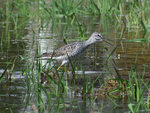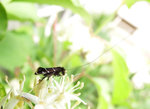


Listen for the loud “klee-klee-klee” call of greater yellowlegs in estuaries and flooded fields. This shorebird passes through the Key Peninsula during spring and fall migrations. Watch it strut through shallow water with swagger as it searches for invertebrates. I’ve had good luck finding them at the undeveloped Haley State Park lagoon.
Among all the wild blooms of May, a patch of western trumpet honeysuckle makes me especially happy. The bright orange tubes of these flowers — beloved by hummingbirds and nectar-sucking kids — emerge from one of our only native vines. I know of one honeysuckle vine that has climbed a 20-foot dogwood tree. The two flower together, creating a fountain of white stars and orange spray. Look for honeysuckle in open forests. Rocky Creek Conservation Area has an impressive concentration of them.
On May 15 around 9 p.m., the moon will rise a dark red shadow of itself in full lunar eclipse. It will still be low over the horizon when the eclipse ends around 11 p.m. Choose a vantage with a full view to the east.
Watch for butterflies and early dragonflies, yes, but also watch for day-flying moths. A few species of moth prefer daytime, like the bumblebee-mimicking clearwing moth. Around fragrant shrubs like oceanspray keep your eyes open for my personal favorite, Adela septentrionella, a species of longhorn fairy moth without a common name. It is quite small. On its black wings are two white stripes and seven white dots. Most notably, its antennae are ridiculously long, more than twice as long as the moth itself.
Salamanders and Newts
Q: What is the difference between a salamander and a newt? Which do we see around here? — Several readers ask.
A: It’s kind of a trick question. Newts are a type of salamander but distinct enough to warrant their own name. Like all salamanders, newts have four short legs sticking out from a sinuous body, a long tail, a blunt nose, and a reliance on damp places, as they are thin-skinned amphibians. Unlike typical salamanders, however, their skin is rough and grainy rather than smooth and shiny, and they lack the vertical rib lines called costal grooves.
The single species of newt here, rough-skinned newt, is brown on top and bright orange below. It is far more commonly encountered than its salamander cousins; its extreme toxicity allows it to wander around in broad daylight without fear of predators. It can be found in forests or stagnant water. Its aquatic form has a flattened, eel-like tail.
Several species of salamanders are possible residents of the Key Peninsula. All are secretive. They are best found by going out on a rainy spring night with a flashlight when they may be on the loose. Otherwise, they like to hide out in decaying stumps, rodent burrows and loose bark.
My most recent salamander encounter might offer as good a strategy for finding them as any. I was in a brushy area where several months before I had cut a downed tree into firewood. I noticed a piece of firewood I had left behind and went down to retrieve it. Underneath was a long-toed salamander, the first I had ever seen, its dark shining sides speckled with white. You never know. Next time you cut firewood, try leaving one behind.
Where have you found salamanders on the Key Peninsula? I want to hear. Salamanders are sensitive to environmental disturbance. There are several species that may be here or may not.
At least 13 species of salamander live in Washington, including several species of torrent salamander, a family of small salamanders that exist only in the Pacific Northwest, and the coastal giant salamander, which can push 14 inches in length.
Salamanders can regenerate lost limbs. Some, like Cope’s giant salamander in the Olympic Mountains, almost never metamorphose into adults but opt to reproduce as aquatic larvae. Speaking of aquatic larvae, which breathe through external gills spread like fans behind their heads, salamanders have all kinds of different lungs. Some have richly folded lungs like us, while others have almost no lungs at all, breathing instead through their skin or blood vessels in their mouths.
On the Trail of the Elusive Shrew-mole
Since we’re on the topic of elusive critters, I need to tell you about the shrew-mole. It’s real and it’s here. Squat and black-furred, with tiny, hooded eyes and a long snout, it looks like a shrew but is in fact a mole, the smallest of our three species. Its front feet are only moderately elongated and look scaly and translucent, almost reptilian. Its tail is fat and sprouted with thick hairs.
It is just one of a long list of strange animals named for combinations of other animals — see also tiger beetle, dogfish, kangaroo rat, mule deer, deer mouse.
The shrew-mole seems to be completely blind. It travels in loose bands through shaded ravines of salmonberry and maple leaf litter where thick accumulations of humus give cover to its tunnels and runways. Both shrews and moles have famously rabid metabolisms, and the shrew-mole is no exception, burning through a diet of earthworms and insect larvae.
“Probably 99% of a shrew-mole’s active life is spent in a ceaseless quest for food,” wrote two University of Washington researchers in 1942 in what remains the most in-depth study of the shrew-mole. They describe how it raps its prehensile nose three times — forward, left, right — between each scuttling step it takes, so that its movement is a constant frenzied search for the food it cannot see. It climbs low shrubs and can swim with “astonishing” speed. Every 10 minutes or so it takes a power nap.
Captive specimens die within hours if not given food. Which makes me think. At every moment, through every month of the year, in the rain-soaked silence of long nights when we’re all gabbing and sleeping, the shrew-mole is out there in our local ravines on its ceaseless quest. It’s been out there for many thousands of years. Sometimes the chain of life can seem so fragile, linked by moments that depend on chance encounters. It is comforting to think that a blind creature that can neither stockpile nor survive long without food has everything it needs here, at every hour of the year, to satiate its hunger. The land just has that much life in it.
UNDERWRITTEN BY THE FUND FOR NONPROFIT NEWS (NEWSMATCH) AT THE MIAMI FOUNDATION, THE ANGEL GUILD, ADVERTISERS, DONORS AND PEOPLE WHO SUPPORT INDEPENDENT, NONPROFIT LOCAL NEWS